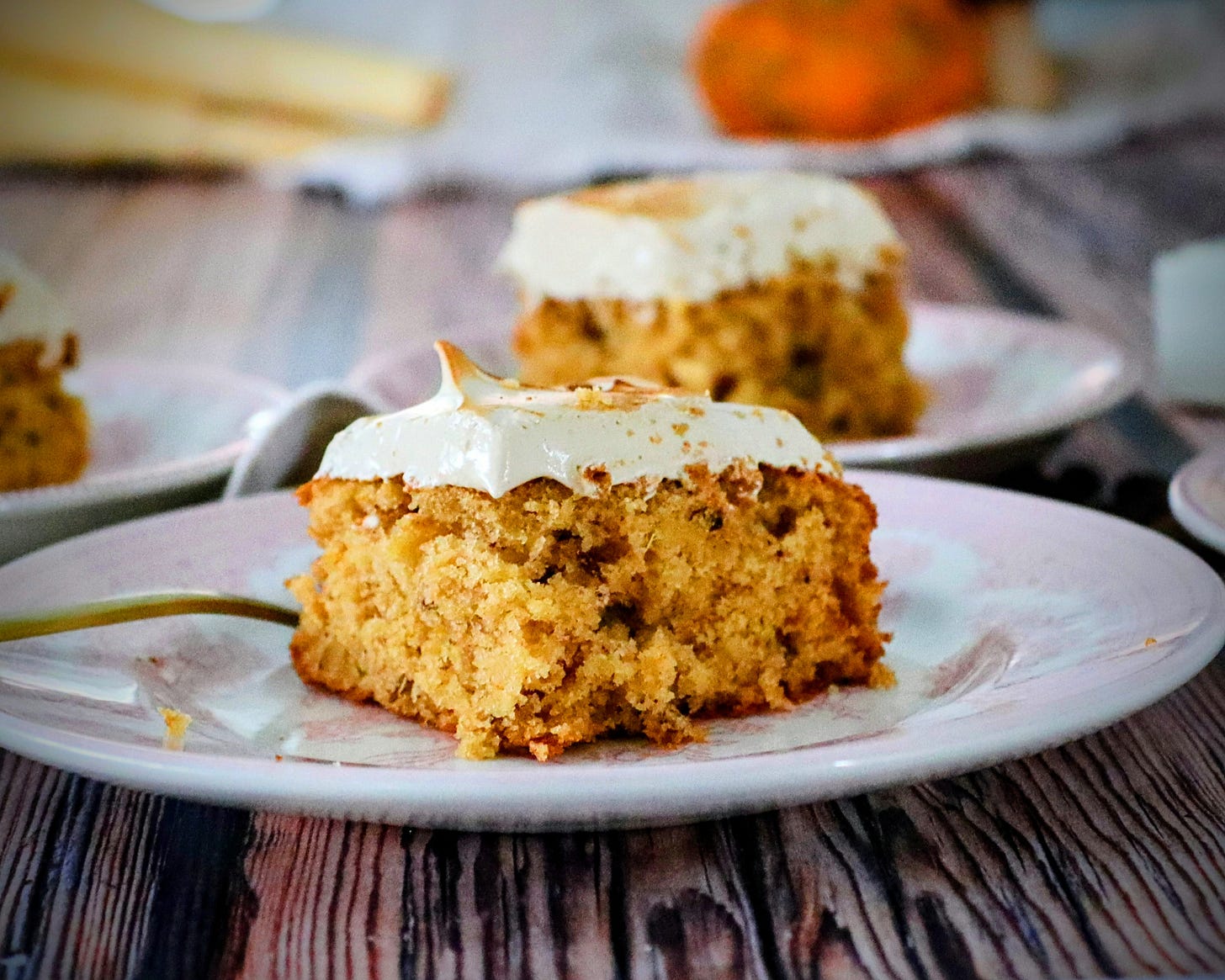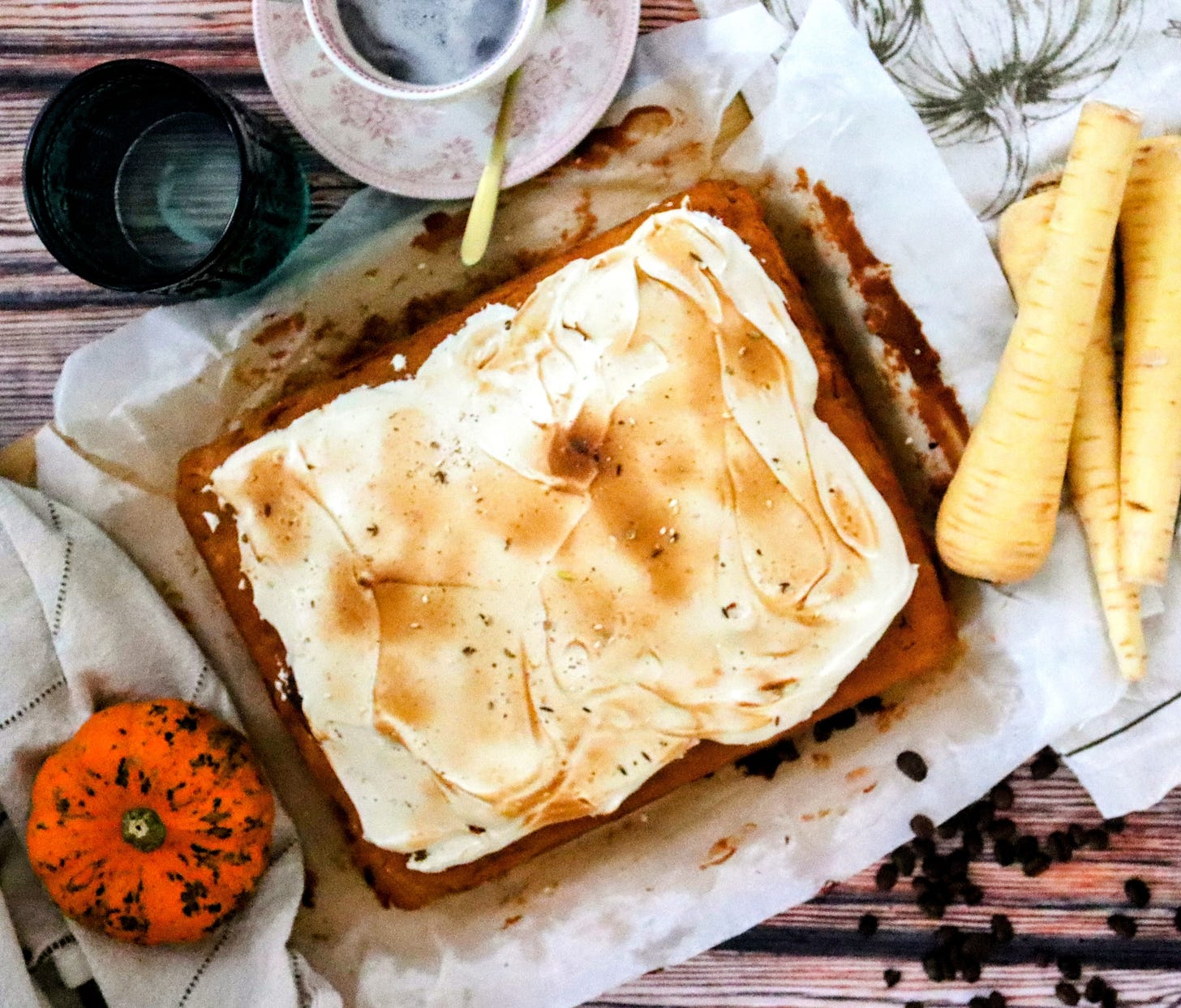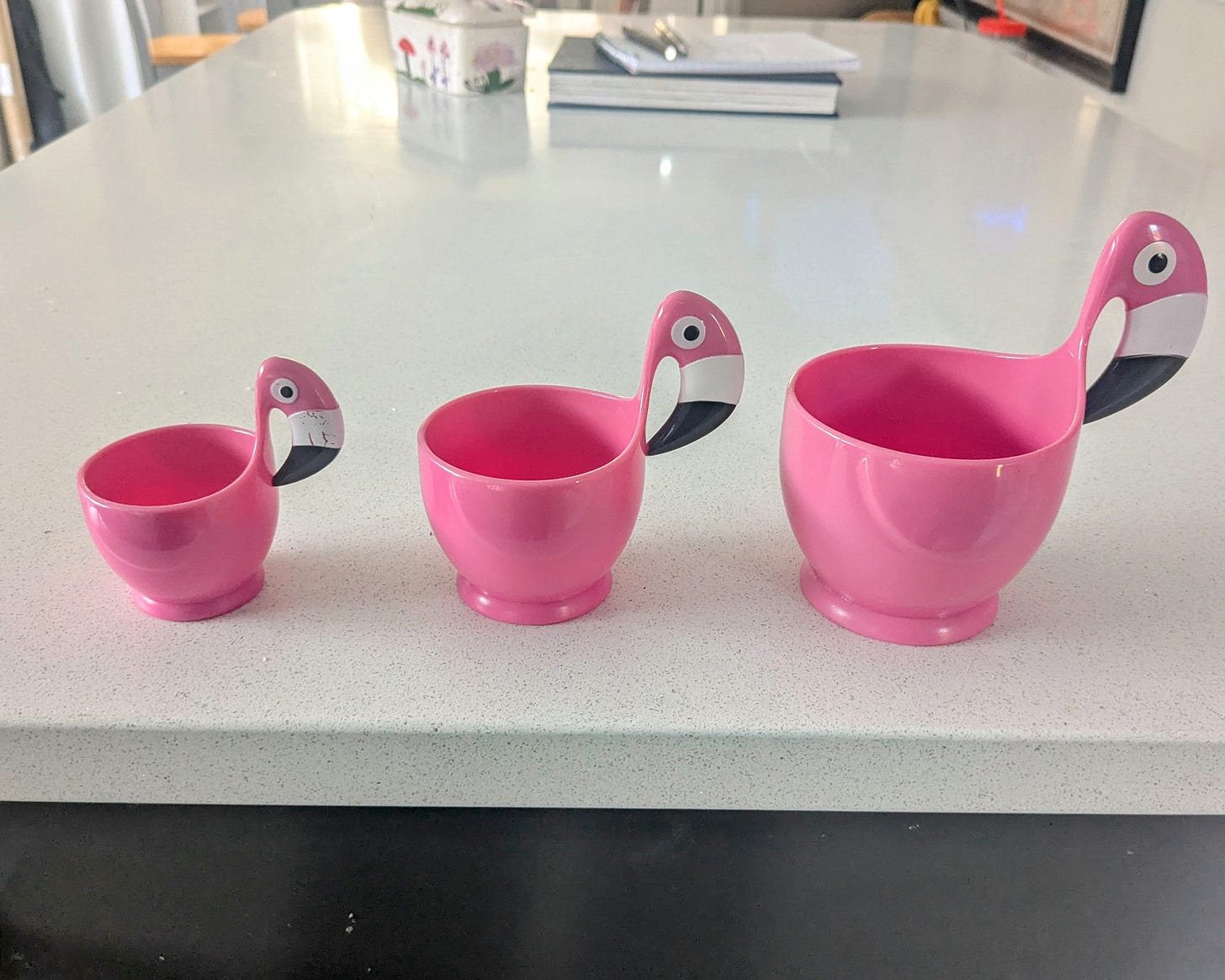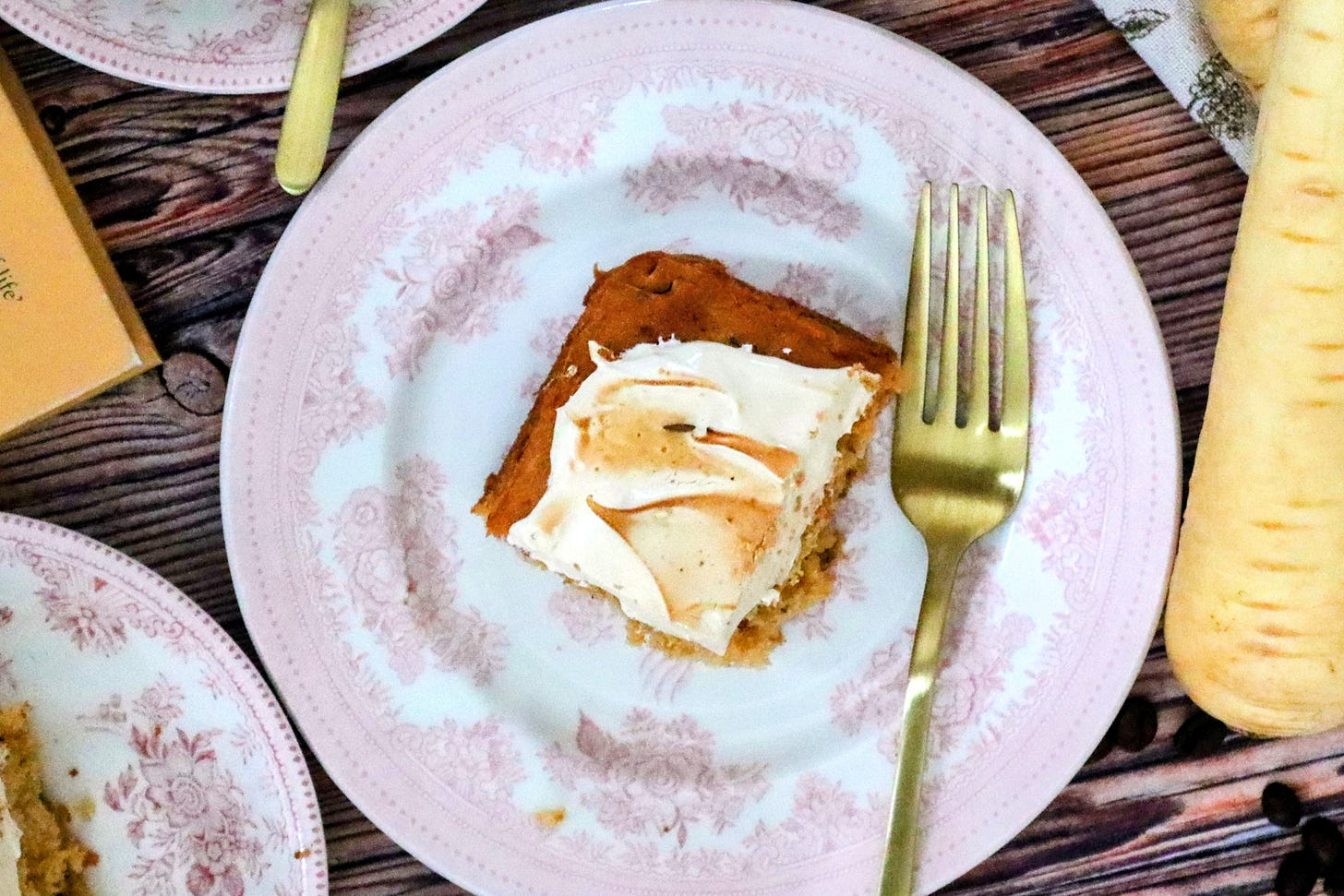Dukkah Spiced Parsnip Cake
With a Torched Coffee Meringue
Hello there and welcome back to Bake Experiments - on a mission to make patisserie easier for the home baker. Ta for being here!
As ever, if you like what you read, and I hope you do, I’d be thrilled if you tap that heart, share or subscribe.
The Egyptian spice and nut mix Dukkah is something I have often used in savoury cooking. But sweet? Not so much.
Which is remiss of me, because it works spectacularly.
This week’s bake started life as a carrot cake. Yet the earthy tones from sumac, fennel seeds and sesame in the dukkah proved better bedfellows to the often overlooked parsnip. A more gentle and understated flavour profile than carrot, parsnips bake up beautifully in this golden tray bake. Toasted coffee meringue finishes the cake with indulgence, and whispers of bonfires.
The key technique we are working on this week is using a blow torch, to torch our Italian meringue topping. (Full disclosure, I have pyromaniac tendencies and love a blow torch!) The trick is to work up slowly. As my tutor said in college, you can always add more colour, but you can’t take it away.
In today’s recipe, I’ve included my top blow torching tips and a little video to show my technique.
Nothing is New
David Larbi, writer of Frequently Happy tells us that there is nothing entirely new under the sun. He says:
“Every generation builds on the last; each person learns and improves on the things they come to understand. The same principles are expressed over and over in ways that make sense to people of that time… the same types of entertainment take different forms.”
And so it is with recipes. This week, I have been inspired by three food writing Substackers. I have been a magpie with this cake, pulling shiny little bits from here, there and everywhere to create something ‘new’. Or at least, my personal Autumnal mash up, with healthier notes too.
Some Recommendations
Just Really Good Recipes
The dukkah in this recipe is adapted from a version by
, who writes a gorgeous stack Just Really Good Recipes, full of accessible recipes she makes for her family. Her version of dukkah is super easy and banging with flavour.I have adapted her recipe slightly, so it would fit with a sweet cake. Omitting the salt and pepper, and the walnuts. (Ok, that was merely because I had run out. Walnuts would still work.) I also kept the nuts quite chunky, while ensuring the seeds were ground quite finely. I like a bit of bite in a cake, but wanted to avoid the chew of the seeds.
Real Simple Food
Secondly, the lovely
, who encourages us try different flavours and condiments from our pantries in our baking.I have been following her excellent ‘fall baking tips’ (Autumn in my land). On her suggestion, this recipe today includes lightly toasted flour, for extra depth. Adding to the Autumnal vibes of honeyed parsnip and torched meringue.
Eating and Feeding
Finally, to
, a retired cancer doctor who has your health front of mind in her Eating and Feeding stack. We wrote a post together earlier this year covering baking and healthy eating.Ever since, I have been adapting my baking to take on a healthier slant. As a result, this cake today is a riff on lighter baking Queen Lorraine Pascale’s Parsnip and Pecan tray bake, which has less sugar and more parsnip than your average parsnip cake.
I have made a parsnip cake in the past which included just one sad, little parsnip. This one has closer to four medium parsnips, giving this tray bake a soft, moist crumb. And I’ve left them unpeeled. Good for food waste, and, as Ellen tells us, the peel is higher in total polyphenols and antioxidant activity.
I have also used walnut oil, which is a rich source of mono and polyunsaturated ‘good’ fats.
A confession, all this is somewhat diminished by the toasted meringue topping, which takes the flavour profile to another level. It’s flamin’ divine - but full of sugar. I have tried to use only a small slather though, rather than the piled high meringue toppings you sometimes see.
If you prefer, this cake is moist and flavourful enough to be enjoyed without the topping. You can also use wholemeal flour and unsalted butter, although that’s a little too savoury for my palate.
A note about cup measurements
As two of these lovely stackers are Americans… I’ve included cups measurements. I’m all about making patisserie easier after all!
Cups are an extremely alien concept to me - I think in grams and weight ratios. I did not grow up using cups to bake. In fact, I’ve only just started using them since cooking or baking American recipes from Substack. (Some of you will be acquainted with my cute flamingo set.)
But you know what, for the cake itself, it worked out fine. The meringue topping… bit more of a struggle. This is an Italian meringue which requires some precision. But I’ve given it a go and given both measurements in this recipe.
When it comes to baking, I genuinely would always advise using a scale and going for grams. I’m not being snobby, it’s about that precision. But going forward, I will include measurements in cups where I can. And I will do this tested, rather than a website conversion.
Although for some trickier patisserie, I may have to stick with just grams. My thinking dear reader, is that if you are up for taking on an éclair, you are probably up for buying a scale.
If you are already subscribed to Bake Experiments and are enjoying what you read, please do consider upgrading to a paid subscription - everything I personally earn from Substack in 2025 I will donate to The World Central Kitchen and FoodCycle.
Prefer to leave a one off donation? You can tip here:
Thank you to everyone for your donations, and to paid subscribers, so far!
Dukkah Spiced Parsnip Cake, with Torched Coffee Meringue
The strong flavours of dukkah and coffee stand up to each other in this comforting and toasty Autumnal bake - an alternative to the more traditional carrot cake. A handful of raisins or sultanas may also prove an interesting addition, if you wish to experiment.
Level: Intermediate (due to the meringue topping, the cake itself is very easy.)
Time: 2 hrs
Serves: Makes Approx. 16 squares
Specialist Equipment needed: 1x 20cm by 25cm tray, sugar thermometer. Stand mixer and blow torch useful but not essential.
Ingredients:
For the cake
250g/3 cups grated parsnips (unpeeled)
200g/1.5 tightly packed cups of plain flour
50g/1/3 cup light brown sugar
50g/1/3 cup light muscovado sugar
75g/1/2 cup salted butter
50ml/1/4 cup walnut oil
2 tbsp honey
1 tsp orange zest
3x eggs
2 tsp baking powder
3 tbsp Sheryl O’Connell’s dukkah mix, omitting the salt and pepper. Ensure you grind the seeds fairly finely, but keep the nuts quite chunky.
Coffee Italian Meringue
55g/1/4 cup egg white
140g/1/2 cup light brown sugar
2 tbsp water
1/2 tbsp instant coffee, dissolved in 1 tbsp boiling water
Method
Preheat your oven to 180°C/160°C Fan/356°F
Grease your tray with butter and line with parchment paper.
Start by lightly toasting your flour. I did this in a wide frying pan on a medium heat for 5-10 minutes. Gently moving the flour around with a spatula so it evenly browned. I did this until the flour took on a very light brown hue and smelt toasty. Set aside to cool slightly. Your kitchen will smell amazing!
Turning my stand mixer onto a medium speed, I added all of the cake ingredients one by one until they were well combined. If you don’t have a stand mixer, an electric whisk will suffice.
Pour your batter into your lined tray, smooth it out with a spatula and place in the oven for 30 minutes. I always pop a small pot of water into the bottom of the oven too. I find this helps makes your sponge wonderfully moist.
When it’s done, your cake will spring back to the touch, and a toothpick should come out clean.
Leave to cool.
Now, move on to your Italian meringue:
Add your egg whites with a squeeze of lemon juice and begin whisking at a low speed.
Place your water and light brown sugar into a small pan.
Put your saucepan on a medium high heat and cook. Do not stir it! You can swirl it round if you need to cover any sugar with the water.
With your sugar thermometer, test the syrup. Once it reaches 105°C, increase the speed of the mixer.
When the sugar reaches 118°C - known as ‘softball’ stage, reduce the speed of your mixer and gently pour the sugar into the whisking egg whites.
Add your coffee. Turn your mixer back up and mix for around ten minutes. You’ll know it’s done when you touch the side of the bowl and it’s no longer warm. The meringue should also hold its shape when you pull the whisk out.
Take your cooled parsnip cake out of the tin.
Using a small palette knife. Gently smooth over your coffee meringue so it's around 1cm thick.
Next, it's blow torch time!
Here are my top tips for using your blow torch:
If you don’t have a blow torch, simply pop your cake under the grill until it has a light brown colour.
I use a small Tala kitchen blowtorch.
Please make sure you keep anything flammable at a distance, roll up sleeves, keep hair out of the way. Stay safe.
Turn it on and angle the blowtorch at Approx. 45 degrees, and around 5cms away from the meringue. Don't go too close, I have certainly singed some meringue kisses this way!! If you aren’t getting a strong enough colour, go a little closer.
Gradually work across the traybake, building up the colour to your personal liking. I like a golden caramel colour.
Here's my technique below. I have kept this video slow, so you can see how gradually I add the colour.
This isn't what cooks the egg, the sugar syrup you use when you make your Italian meringue does that. This is to give another dimension of toasty favour. So, there is no need to be concerned from a safety perspective and go overboard with the blow torching.
But, if you have any concerns, use a Swiss meringue instead, which also works beautifully with light brown sugar. You will watch your egg white cook to 70-80°C, to ease any worries.
Once you are happy with your torched meringue situation. Sprinkle with a little more dukkah. Then place the cake in the fridge for around an hour. This is the first step to cutting perfectly neat and even squares.
Once the cake is firmer, take it out of the fridge and measure out your squares. I go 5cm by 5cm, marking the edge of the cake with a knife.
Once you are ready to cut, press down with a serrated knife, before gently pulling out. (Don’t lift up!) This helps to ensure your cut is clean.
These will keep for 2-3 days at room temperature. Lovely with a cosy coffee.
Until next time…
Have you heard about the Bake Experiments Recipe Index? An easily searchable one stop shop for all Bake Experiments recipes and experiments.







Shell this is a baking triumph. Parsnips yum, walnut oil tick, Dukkha inspired, and Italian meringue decadent. Congratulations Shell, this is baking brilliance.
So happy to be an inspiration for this beautiful marriage of flavors. Oh, to be a fly on the wall back in your ‘blow torch’ college. I like how you reduced the butter for walnut oil and added more nuts to a parsnip-based torte - intentional eaters can get in more polyphenols while eating a simply delicious dessert